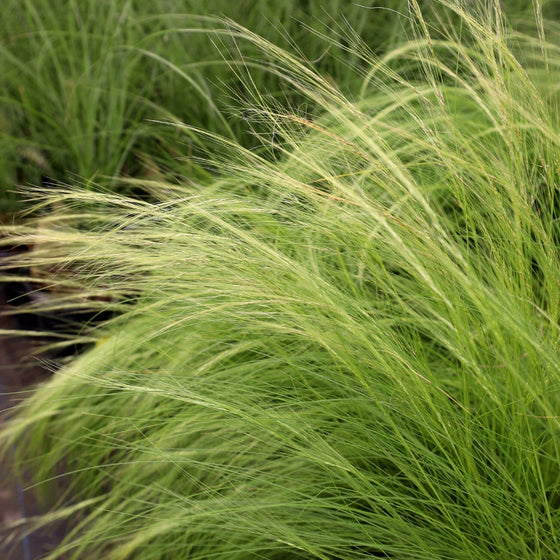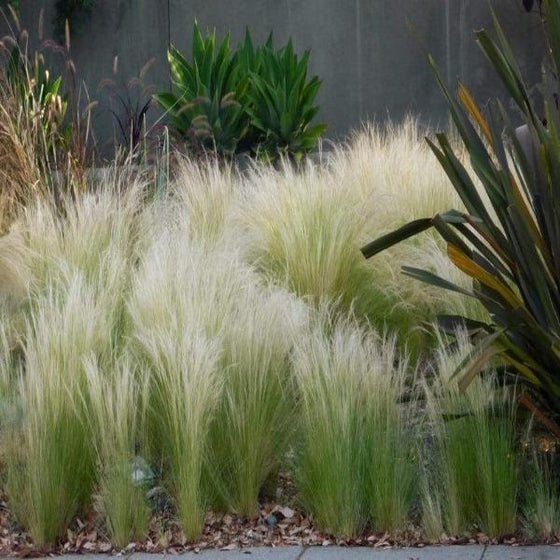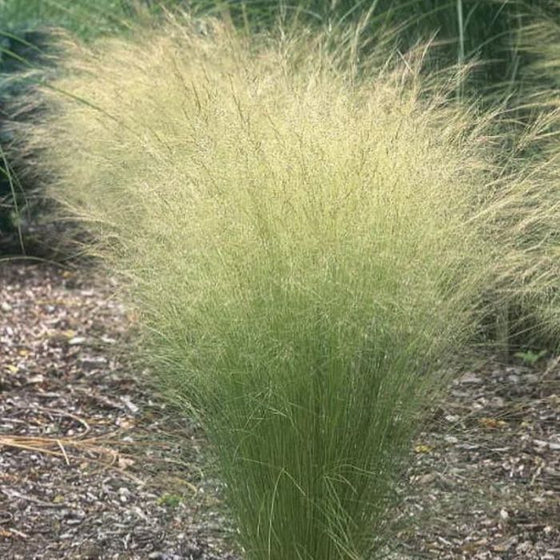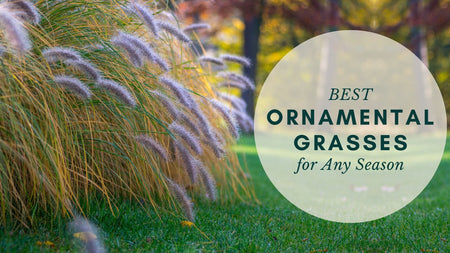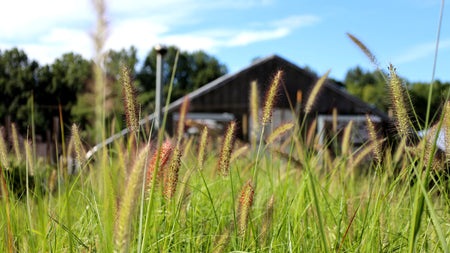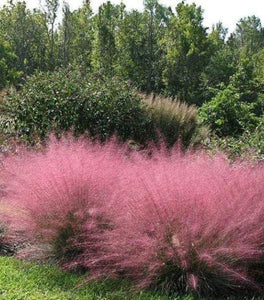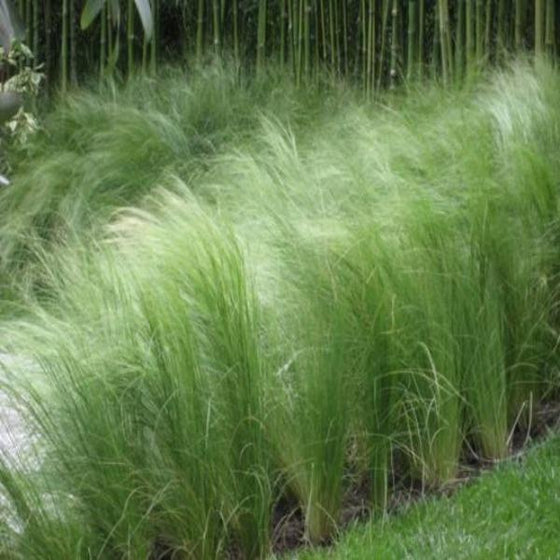
Images Depict Mature Plants
Mexican Feather Grass for Sale Online
Mexican Feather Grass (Nassella tenuissima or Stipa tenuissima) is a delicate, ornamental grass known for its soft, flowing texture and graceful movement in the wind. Its fine, wispy blades are a rich green during the growing season, turning a beautiful golden tan in the fall, adding year-round interest to any garden. This versatile grass grows 1-2 feet tall and wide, making it an ideal choice for borders, rock gardens, or an accent plant in mixed landscape designs. Hardy in USDA Zones 6-10, Mexican Feather Grass thrives in full sun and well-drained soil, and it is drought-tolerant once established, requiring minimal maintenance.
Perfect for low-water or xeriscape gardens, Mexican Feather Grass brings a natural, airy feel to the landscape. Its fine texture contrasts beautifully with bold-leaved perennials, succulents, or other ornamental grasses. Its soft, flowing appearance adds movement and dimension to garden beds and containers, whether used in mass plantings or as a standalone feature. The golden hues that develop in the fall create a striking visual display that lasts throughout the colder months, providing seasonal interest even when other plants have gone dormant.
In addition to its visual appeal, Mexican Feather Grass is a hardy, low-maintenance plant that is easy to grow. It is highly adaptable, tolerating poor soil conditions, heat, and drought, making it perfect for regions with dry climates or where water conservation is a priority. This ornamental grass is also deer-resistant, adding to its versatility in the landscape. With its soft texture, flowing form, and year-round beauty, Mexican Feather Grass is a must-have for gardeners looking to create a dynamic, low-maintenance garden.
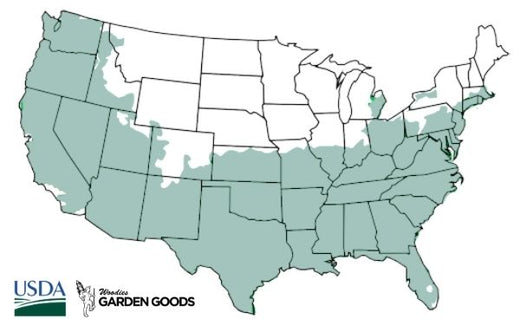
| Hardiness Zone: | 6-10 |
|---|---|
| Mature Height: | 1 to 2 Feet |
| Mature Width: | 1 to 1.5 Feet |
| Sunlight: | Part sun to full sun |
| Water Requirements: | Water well only until established |
| Selling Points: | Heat and drought tolerant, deer resistant |
| Details: | Tan flowers on thin, bright green foliage in late summer; moves in the slightest breeze |
How to Care for Mexican Feather Grass
Before you buy Mexican Feather Reed Grass, make sure to read about the recommended care instructions to keep this plant healthy and thriving.
How Do I Plant Mexican Feather Grass?
To plant Mexican Feather Grass, start by selecting a location with full sun and well-drained soil, as this ornamental grass thrives in bright light and drier conditions. Dig a hole twice as wide as the root ball but only as deep, allowing the roots to spread easily. Place the grass in the hole, making sure the top of the root ball is level with the surrounding soil. After planting, backfill the hole with native soil and water thoroughly to help establish the roots. Mexican Feather Grass prefers slightly sandy or rocky soil, so avoid areas with heavy clay or poor drainage, as it can cause root rot. Once planted, Mexican Feather Grass requires minimal maintenance. Water regularly during the first growing season to help the roots establish, but once established, it is highly drought-tolerant and only needs occasional watering during prolonged dry spells. Space the plants about 1-2 feet apart to allow for their mature size and to create a soft, flowing effect in the landscape. Mulching around the base of the plant can help retain moisture and suppress weeds, though this grass thrives best in low-fertility soils and doesn’t require much feeding. With proper planting and care, Mexican Feather Grass will add texture, movement, and low-maintenance beauty to your garden.
How do I Water Mexican Feather Grass?
To properly water Mexican Feather Grass, it’s important to keep the soil moist during the first growing season to help the plant establish strong roots. Water deeply once or twice a week, especially during dry spells, ensuring the moisture reaches the root zone. Once established, Mexican Feather Grass becomes highly drought-tolerant and requires minimal watering. At that point, water the plant sparingly, only during prolonged periods of heat or drought. This ornamental grass thrives in well-drained soil, so avoid overwatering, as soggy soil can lead to root rot. In terms of maintenance, Mexican Feather Grass performs best when the top few inches of soil dry out between watering sessions. For container-grown plants, check the soil regularly and adjust watering frequency as needed, as pots tend to dry out faster than in-ground plantings. Mulching around the base of the plant can help retain moisture during hot months, but be sure not to let the plant sit in overly damp conditions. By watering Mexican Feather Grass properly, you’ll encourage its natural drought resistance and enjoy its graceful, flowing texture in the landscape with minimal effort.
How do I Fertilize Mexican Feather Grass?
Mexican Feather Grass is a low-maintenance plant that thrives in poor to moderately fertile soils, so it doesn’t require heavy fertilization. In fact, too much fertilizer can lead to overly lush, floppy growth, which detracts from the plant’s natural, airy appearance. For best results, apply a light, balanced fertilizer, such as a 10-10-10 formula, in early spring when new growth begins to emerge. Alternatively, you can add a thin layer of organic compost around the base of the plant to provide slow-releasing nutrients. Water thoroughly after fertilizing to help the nutrients reach the roots without overwhelming the plant. Since Mexican Feather Grass prefers low-fertility soils, it’s generally unnecessary to fertilize more than once a year. In fact, this drought-tolerant grass performs well in nutrient-poor soils, making it ideal for xeriscaping and low-maintenance gardens. Avoid over-fertilizing, as it can cause the grass to become leggy and lose its graceful, compact form. By using a light touch with fertilizer, you can ensure that Mexican Feather Grass maintains its delicate, flowing texture and continues to thrive with minimal care in your landscape.

How do I Prune Mexican Feather Grass?
Pruning Mexican Feather Grass is a simple task that helps maintain its neat, graceful appearance throughout the growing season. The best time to prune is in late winter or early spring, just before new growth starts. Use clean, sharp pruning shears to cut back any dead or damaged foliage, trimming the grass to about 3-4 inches from the ground. This allows room for fresh, vibrant green blades to emerge. Avoid cutting too far into the crown of the plant, as this can damage the growing points. Removing dead foliage not only refreshes the plant’s appearance but also encourages healthy new growth. Throughout the growing season, Mexican Feather Grass generally requires minimal pruning, as its wispy, flowing nature is part of its charm. However, you can perform light pruning in the summer if any stray or overly long blades detract from its overall shape. Simply trim the tips to maintain a tidy appearance, but avoid cutting too much, as this can disrupt its natural, airy look. By regularly removing spent or damaged blades, your Mexican Feather Grass will continue to thrive, providing soft movement and texture in your landscape year-round.

